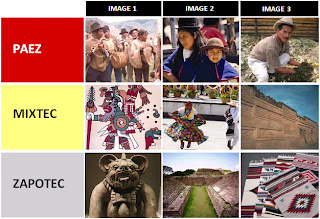Images depicting the architecture, art and artifacts of the major indigenous cultures of Latin America.
Tupi Image 1: Painting entitled 'Tupi woman' from the National Museum of Denmark
Tupi Image 2: A Tupiniquim chief (Cacique) in (Brasília, 2007)
Tupi Image 3: Albert Eckhout: a mixed-race (Mameluco) woman (circa 1641–1644)
Tapuia Image 1: Castelo da Tapuia - Sítio Novo
Tapuia Image 2: Painting entitled 'Dança dos Tapuias', Albert Eckhout
Tapuia Image 3: Painting entitled 'Brazilian Tapui Man', Albert Eckhout
Musica Image 1: Model of ancient Muisca houses in the Archaeology Museum of Sogamoso
Musica Image 2: Ruins of an ancient Muisca temple in the Villa de Leyva near El Infiernito
Musica Image 3: Muisca raft (1200–1500 BC), representation of the initiation of the new Zipa in the lake of Guatavita
Taironas Image 1: Tairona figure pendant in gold
Taironas Image 2: Monument in Santa Marta depicting Taironas
Taironas Image 3: Teyuna, The Lost City of Colombia once inhabited by the Tairona people
Guarani Image 1: Guarani village in Itapua, Paraguay
Guarani Image 2: Guaraní incised ceramics bowls, Museum Farroupilha, in Triunfo
Guarani Image 3: A Guaraní family captured by slave hunters. By Jean Baptiste Debret
Aztec Image 1: Aztec pyramid of Santa Cecilia Acatitlan
Aztec Image 2: The Aztec Sun Stone, also known as the Aztec Calendar Stone
Aztec Image 3: Ancient Aztec cookware and pottery
Maya Image 1: The Pyramid of Kukulkan believed to be built before 800 AD, is easily the most impressive and widely recognized of the structures of Mayan architecture.
Maya Image 2: Maya book written in the Maya script
Maya Image 3: The Tablet found in the Temple of the Foliated Cross
Inca Image 1: Perhaps the most renowned aspect of Incan architecture is the use of terraces to increase the land available for farming. Inca agricultural terraces in Pisac
Inca Image 2: Inca drinking goblet
Inca Image 3: An example of Inca pottery art
Wayuu Image 1: Wayuu handcrafted mochilas woolen bags
Wayuu Image 2: Wayuu improvised hutch to hang hammocks
Wayuu Image 3: A Wayuu rancheria
Warao Image 1: Warao Baskets - They wrap these fibers around a coil of a palm branch. This technique offers us some of the strongest and tightest weaves available. The Warao baskets are some of the finest in the world today.
Warao Image 2: Thatched roof housing on the banks of the Orinoco river in Venezuela
Warao Image 3: A Warao family using a monoxylon on a small Orinoco Delta caño, located near the Monagas border with Delta Amacuro in Venezuela.
Pemon Image 1: A Pemon village depicting typical housing
Pemon Image 2: Young child wearing a traditional Pemon headdress
Pemon Image 3: Pemon arts and crafts on display
Yanomami Image 1: Yanomami Carrying Basket, woven with the fibers of the mamure plant
Yanomami Image 2: Brazil Amazon rainforest Yanomami Indian girl
Yanomami Image 3: A shabono hut, used by the Yanomami Amerindians of extreme southern Venezuela and extreme northern Brazil. Used as temporary dwellings, they are traditionally constructed mainly of thatched palm leaves and wood.
Carib Image 1: Painting which depicts Caribs as the descendants of West Africans, whose members were captured along the West African seaboard and from the interior and who were exchanged for trade goods, enslaved, and transported across the Atlantic to work on the plantations of the islands.
Carib Image 2: Canoe fashioned from wood and thatched roof dwelling
Carib Image 3: Carib natives holding a woven basket
Arawak Image 1: Drawing depicting an Arawak maiden and waterfall
Arawak Image 2: In all Arawak settlements several families shared one house, which was called a caneye. It was round, and made of wattle with a thatched roof.
Arawak Image 3: Arawak stone carving of a bird
Taino Image 1: Taino stone mask carving
Taino Image 2: Taino Carving found in a cave in Puerto Rico
Taino Image 3: Reconstruction of a Taíno village in Cuba
Miskito Image 1: Miskito Cays Biological Reserve is one of 78 protected areas in Nicaragua
Miskito Image 2: Miskito Indians from Nicaragua wait for food at a Honduran camp
Miskito Image 3: Miskito Tunu Bark Art Piece
Mapuche Image 1: Stone weapons used in Mapuche tribal warfare
Mapuche Image 2: The traditional house, ruka, has a single door, open towards the east, an orientation which expresses the preference of the Mapuche for Puelmapu (Land of the East), where the deities reside.
Mapuche Image 3: Mapuche elder women playing a ceremonial drum
Quechua Image 1: Man playing a traditional Quechua flute
Quechua Image 2: Ruined remains of an ancient settlement built by the Quechua people in the Andes mountains of Peru.
Quechua Image 3: Quechua carved gourd depicting the 1880 Battle of Arica, by Flores Kananga, Peru
Aymara Image 1: Aymara woman dancing Morenada. Bolivia
Aymara Image 2: Aymara women hawking their wares in a local market
Aymara Image 3: At the shores of Lake Umayo, a small lake not 20km from Lake Titicaca, still stand the ancient funerary towers of Sillustani. Thought to be built by the Aymara
Guaymi Image 1: Guaymi indian painting on wood
Guaymi Image 2: Guaymi mother and daughter outside their humble dwelling made of tin, thatch and wood
Guaymi Image 3: A display of Guaymi necklaces
Cueva Image 1: Before the Spanish arrived, this was a village inhabited by the Cueva
Cueva Image 2: Cueva wooden indian sculptures
Cueva Image 3: Cueva handmade rug
Paez Image 1: Paez people playing traditional drums and flutes
Paez Image 2: Mother and child in traditional dress
Paez Image 3: Paez coffee framer in Columbia
Mixtec Image 1: Painting of Mixtec warrior
Mixtec Image 2: Mixtec man and woman performing a traditional dance
Mixtec Image 3: Mixtec geometric stone carving on building facade
Zapotec Image 1: A funerary urn in the shape of a "bat god" or a jaguar, from Oaxaca, AD 300–650
Zapotec Image 2: Ancient Zapotec sports arena
Zapotec Image 3: An assortment of Zapotec rugs













